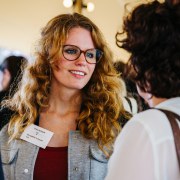Evaluating the impact of sensitive and intangible stories
Conservation of nature, working with death, the time span of the evolution of man and capturing the ‘genius loci’ of a site - four different exhibition topics with one similarity: they are hard to display. The choice of exhibition techniques can be challenging when the narratives are hard to grasp, very sensitive or particularly relevant. But what impact do those techniques actually have? And can we measure the success of our exhibition goals when research on the impact of exhibition techniques is limited?
Four speakers who are tackling difficult exhibition topics share the impact of their approaches (storytelling, multimodal approaches, object presentation) on their visitors. During a lively discussion with participants, we will explore the impact of different types of exhibition strategies and consider suitable research methods to evaluate them, finding out which strategies worked well when exhibiting sensitive or demanding topics, and what the different research methods have to offer when evaluating exhibition strategies.
Facilitator
Project and Exhibition Manager
Session speakers
The DASA project evaluates the impact of storytelling in the exhibition “Pia says Goodbye. An Exhibition on the Work with Death and Grief”. This case study applies a mixed methods approach (exhibition analysis, questionnaire, guided interviews and participant observations) to assess visitor behaviour, perceptions and learning experiences based on the GLOs. A key question is what visitors take away from a strong and immersive exhibition narrative. Does the story help to dig into this difficult topic? The study is complemented by Jana's foundational PhD research on the definition of storytelling in exhibitions. Jana addresses results and challenges of this ongoing project.
In 2016 the Neanderthal Museum did an update on parts of the permanent exhibition. In the exhibition area “A journey through time” we combined hyperrealistic reconstructions of hominins with personal storytelling, touchable exhibits and classic elements like showcases to show human evolution over the last 7 million years. By doing an evaluation study with mixed methods (observations and interviews) we are trying to find out if and how our visitors perceive something that is so abstract and hard to grasp like long time spans and the everlasting evolutionary process.
PhD-Researcher & Lecturer Media Studies | Mediatised Experiences in Heritage
Amsterdam University of Applied Sciences
How can visitors explore the (in)tangible identities that surround heritage sites, the genius loci, through more than the historical narrative only? Based on examples of two mixed reality experiences at churches, Bernadette addresses how two evaluation methods (emotion-networking method and atmospheric thinking) revealed the potential and challenges of mixed reality technology. Specifically, she looked at how multisensory or ‘embodied’ dialogues with material objects and traces could emerge through this technology, and how visitors might engage with pasts, presents and futures.
Director of contents and science engagement
In 2019 Parque Explora decided to renovate the "Aquarium" exhibition shifting the message to conservation. During the renovation, the team had unanswered questions. For example, what would be the ideal scripts to get people to understand the environmental issue if it is known that information does not change perceptions? In this panel Juliana will address the evaluation results that show us if the conservation message is perceived and if visitors are willing to change attitudes. Additionally, Juliana will dive into what it means for planning exhibitions on environmental issues.





